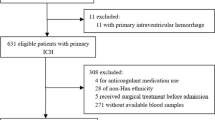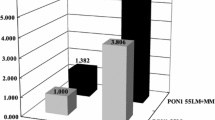Abstract
The human paraoxonase (PON) gene family includes three members: PON1, PON2, and PON3. PON, which prevents the oxidative modification of lipoproteins, has been implicated as a potential risk factor of the cerebrovascular disease. In this study, we investigated associations between coding region single-nucleotide polymorphisms (cSNPs) of PON1, PON2, and PON3 genes and intracerebral hemorrhage (ICH) in a Korean population. Six cSNPs [rs13306698 and rs662 for PON1; rs12026 and rs7493 for PON2; rs13226149 and rs1053275 for PON3] were genotyped using direct sequencing in 145 ICH patients and 372 control subjects. Of the six cSNPs, rs12026 and rs7493, which were in complete linkage disequilibrium, were associated with ICH in log-additive (GC vs. CC vs. GG, p = 0.0008, OR = 0.53, 95 % CI = 0.36–0.78) and dominant models (GC/CC vs. GG, p = 0.0006, OR = 0.47, 95 % CI = 0.30–0.73). In addition, rs13226149 was associated with ICH in log-additive model (GA vs. AA vs. GG, p = 0.0033, OR = 0.58, 95 % CI = 0.39–0.84). In the allele frequency analysis, the C alleles of rs12026 and rs7493 and the A allele of rs13226149 were also shown to contribute to the decreased risk of ICH (p = 0.001, OR = 0.55, 95 % CI = 0.38–0.80 in rs12026 and rs7493; p = 0.003, OR = 0.58, 95 % CI = 0.40–0.83 in rs13226149). These results suggest that PON genes may be involved in the susceptibility of ICH.
Similar content being viewed by others
References
Aviram M, Rosenblat M, Bisgaier CL, Newton RS, Primo-Parmo SL, La Du BN (1998) Paraoxonase inhibits high-density lipoprotein oxidation and preserves its functions. A possible peroxidative role for paraoxonase. J Clin Invest 101(8):1581–1590
Balcerzyk A, Zak I, Krauze J (2007) Synergistic effects between Q192R polymorphism of paraoxonase 1 gene and some conventional risk factors in premature coronary artery disease. Arch Med Res 38(5):545–550
Boright AP, Connelly PW, Brunt JH, Morgan K, Hegele RA (1998) Association and linkage of LDLR gene variation with variation in plasma low density lipoprotein cholesterol. J Hum Genet 43(3):153–159
Campo S, Sardo AM, Campo GM et al (2004) Identification of paraoxonase 3 gene (PON3) missense mutations in a population of southern Italy. Mutat Res 546(1–2):75–80
Coy DH, Hocart SJ, Murphy WA (1991) Human growth hormone-releasing hormone analogues with much improved in vitro growth hormone-releasing potencies in rat pituitary cells. Eur J Pharmacol 204(2):179–185
Hademenos GJ, Alberts MJ, Awad I et al (2001) Advances in the genetics of cerebrovascular disease and stroke. Neurology 56(8):997–1008
Huang Q, Liu YH, Yang QD et al (2006) Human serum paraoxonase gene polymorphisms, Q192R and L55M, are not associated with the risk of cerebral infarction in Chinese Han population. Neurol Res 28(5):549–554
Koch S (2011) Intracerebral hemorrhage: preventing recurrence of ICH—should statins be avoided? Nat Rev Neurol 7(4):193–194
Konishi M, Iso H, Komachi Y et al (1993) Associations of serum total cholesterol, different types of stroke, and stenosis distribution of cerebral arteries. The Akita Pathology Study. Stroke 24(7):954–964
Kumar A, Prasad K, Vivekanandhan S et al (2014) Association between angiotensin converting enzyme gene insertion/deletion polymorphism and intracerebral haemorrhage in North Indian population: a case control study and meta-analysis. Neurol Sci 35(12):1983–1990
Leus FR, Zwart M, Kastelein JJ, Voorbij HA (2001) PON2 gene variants are associated with clinical manifestations of cardiovascular disease in familial hypercholesterolemia patients. Atherosclerosis 154(3):641–649
Lewington S, Whitlock G, Clarke R et al (2007) Blood cholesterol and vascular mortality by age, sex, and blood pressure: a meta-analysis of individual data from 61 prospective studies with 55,000 vascular deaths. Lancet 370(9602):1829–1839
Mackness MI, Harty D, Bhatnagar D et al (1991) Serum paraoxonase activity in familial hypercholesterolaemia and insulin-dependent diabetes mellitus. Atherosclerosis 86(2–3):193–199
Mackness MI, Arrol S, Abbott C, Durrington PN (1993) Protection of low-density lipoprotein against oxidative modification by high-density lipoprotein associated paraoxonase. Atherosclerosis 104(1–2):129–135
McElveen J, Mackness MI, Colley CM, Peard T, Warner S, Walker CH (1986) Distribution of paraoxon hydrolytic activity in the serum of patients after myocardial infarction. Clin Chem 32(4):671–673
Pasdar A, Ross-Adams H, Cumming A et al (2006) Paraoxonase gene polymorphisms and haplotype analysis in a stroke population. BMC Med Genet 7:28
Primo-Parmo SL, Sorenson RC, Teiber J, La Du BN (1996) The human serum paraoxonase/arylesterase gene (PON1) is one member of a multigene family. Genomics 33(3):498–507
Puddey IB (1996) Low serum cholesterol and the risk of cerebral haemorrhage. Atherosclerosis 119(1):1–6
Ranade K, Kirchgessner TG, Iakoubova OA et al (2005) Evaluation of the paraoxonases as candidate genes for stroke: Gln192Arg polymorphism in the paraoxonase 1 gene is associated with increased risk of stroke. Stroke 36(11):2346–2350
Shin BS (2009) Paraoxonase gene polymorphism in south-western Korean population. J Korean Med Sci 24(4):561–566
Slowik A, Turaj W, Dziedzic T et al (2004) DD genotype of ACE gene is a risk factor for intracerebral hemorrhage. Neurology 63(2):359–361
Slowik A, Wloch D, Szermer P et al (2007) Paraoxonase 2 gene C311S polymorphism is associated with a risk of large vessel disease stroke in a Polish population. Cerebrovasc Dis 23(5–6):395–400
Southerland AM, Malik S, Johnston KC (2011) Symptomatic ICH and outcomes in patients after IV tPA: a business of risk or risky business? Neurology 77(4):315–316
Tirschwell DL, Smith NL, Heckbert SR, Lemaitre RN, Longstreth WT Jr, Psaty BM (2004) Association of cholesterol with stroke risk varies in stroke subtypes and patient subgroups. Neurology 63(10):1868–1875
Uzun H, Karter Y, Aydin S et al (2004) Oxidative stress in white coat hypertension; role of paraoxonase. J Hum Hypertens 18(7):523–528
Voetsch B, Benke KS, Panhuysen CI, Damasceno BP, Loscalzo J (2004) The combined effect of paraoxonase promoter and coding region polymorphisms on the risk of arterial ischemic stroke among young adults. Arch Neurol 61(3):351–356
Wang X, Fan Z, Huang J et al (2003) Extensive association analysis between polymorphisms of PON gene cluster with coronary heart disease in Chinese Han population. Arterioscler Thromb Vasc Biol 23(2):328–334
Wang X, Dong Y, Qi X, Huang C, Hou L (2013) Cholesterol levels and risk of hemorrhagic stroke: a systematic review and meta-analysis. Stroke 44(7):1833–1839
Wheeler JG, Keavney BD, Watkins H, Collins R, Danesh J (2004) Four paraoxonase gene polymorphisms in 11212 cases of coronary heart disease and 12786 controls: meta-analysis of 43 studies. Lancet 363(9410):689–695
Woo D, Sauerbeck LR, Kissela BM et al (2002) Genetic and environmental risk factors for intracerebral hemorrhage: preliminary results of a population-based study. Stroke 33(5):1190–1195
Woo D, Kaushal R, Chakraborty R et al (2005) Association of apolipoprotein E4 and haplotypes of the apolipoprotein E gene with lobar intracerebral hemorrhage. Stroke 36(9):1874–1879
Xiao ZJ, Chen J, Sun Y, Zheng ZJ (2009) Lack of association between the paraoxonase 1 Q/R192 single nucleotide polymorphism and stroke in a Chinese cohort. Acta Neurol Belg 109(3):205–209
Xu HW, Yuan N, Zhao Z et al (2008) Study of the relationship between gene polymorphisms of paraoxonase 2 and stroke in a Chinese population. Cerebrovasc Dis 25(1–2):87–94
Zhang G, Li W, Li Z et al (2013) Association between paraoxonase gene and stroke in the Han Chinese population. BMC Med Genet 14:16
Zhang R, Wang X, Tang Z et al (2014) Apolipoprotein E gene polymorphism and the risk of intracerebral hemorrhage: a meta-analysis of epidemiologic studies. Lipids Health Dis 13:47
Acknowledgements
This work was supported by a grant from Kyung Hee University in 2012 (KHU-20121738).
Author information
Authors and Affiliations
Corresponding author
Electronic Supplementary Material
Below is the link to the electronic supplementary material.
Supplementary Fig 1
Linkage disequilibrium (LD) block between single nucleotide polymorphisms (SNPs) of the PON genes. Six SNPs of the PON genes were analyzed for LD using Haploview 4.2. LD block (block 1) is constructed between rs7493 and rs12026 (D′ = 1.00, r 2 = 1.00). Black shading indicates strong LD. The numbers within quadrangles mean D′ × 100 (DOCX 514 kb)
Rights and permissions
About this article
Cite this article
Park, H.J., Kim, S.K., Park, HK. et al. Association Between Paraoxonase Gene Polymorphisms and Intracerebral Hemorrhage in a Korean Population. J Mol Neurosci 57, 410–416 (2015). https://doi.org/10.1007/s12031-015-0620-8
Received:
Accepted:
Published:
Issue Date:
DOI: https://doi.org/10.1007/s12031-015-0620-8




